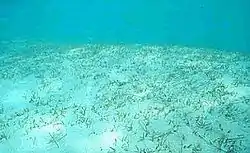Halophila johnsonii
Halophila johnsonii, or Johnson's seagrass, is a small, asexual seagrass in the family Hydrocharitaceae (the "tape-grasses"). It occurs only on the southeastern coast of Florida, and was the first marine plant listed on the United States endangered species list, though it was removed from listing in April 2022.[3] Female flowers have been observed, but even with decade long observational studies, neither male flowers nor seed have ever been observed.[2]
| Johnson's seagrass | |
|---|---|
 | |
| Closeup of a bed of Johnson's seagrass | |
| Scientific classification | |
| Kingdom: | |
| (unranked): | |
| (unranked): | |
| Order: | |
| Family: | |
| Genus: | |
| Species: | H. johnsonii |
| Binomial name | |
| Halophila johnsonii Eiseman and McMillan[2] | |

It may have the most limited distribution of all seagrasses. It occurs only in lagoons along roughly 200 km of the Florida coastline between Sebastian Inlet and the northern part of Biscayne Bay, where it grows in small patches of a few centimeters to a few meters in diameter at depths ranging from the intertidal zone down to 3 meters.[2]
Prior to 1980, the species designation was uncertain. It was sometimes referred to as either Halophila decipiens or H. baillonis Ascherson, despite most closely resembling H. ovalis.[2]
Morphologically, Johnson's seagrass is recognized by the presence of pairs of linearly shaped foliage leaves, each with a petiole formed on the node of a horizontally creeping rhizome. The rhizome is located at or just below the sediment surface and is anchored to unconsolidated substrate by unbranched roots. The leaves are generally 2-5 cm long (including the petioles), and the rhizome internodes rarely exceed 3-5 cm in length, making this species appear diminutive relative to the larger seagrasses.[2]
Both the Green sea turtle and the West Indian manatee are known to feed upon the plant, as well as some herbivorous fish. However, the main threat to species survival is probably human activity.[2] Processes that threaten the plant include eutrophication, dredging, turbidity, and thermal pollution.[4]
References
- Short, F.T.; Carruthers, T.J.R.; van Tussenbroek, B.; Zieman, J.; Kenworthy, W.J. (2010). "Halophila johnsonii". IUCN Red List of Threatened Species. 2010: e.T173324A6990996. doi:10.2305/IUCN.UK.2010-3.RLTS.T173324A6990996.en. Retrieved 24 December 2022.
- National Marine Fisheries Service. 2002. Recovery plan for Johnson's Seagrass (Halophila johnsonii). Prepared by the Johnson's Seagrass Recovery Team for the National Marine Fisheries Service, Silver Spring, Maryland.
- "Endangered and Threatened Wildlife and Plants; Removal of Johnson's Seagrass From the Federal List of Threatened and Endangered Species Including the Corresponding Designated Critical Habitat". unblock.federalregister.gov. 2022-04-14. Retrieved 2023-07-26.
- Halophila johnsonii. The Nature Conservancy.
External links
- Removal of Johnson's Seagrass From the Federal List of Threatened and Endangered Species NOAA Fisheries page with details of de-listing of Johnson's seagrass

